Paddleboards with Engines: Innovation in Water Sports

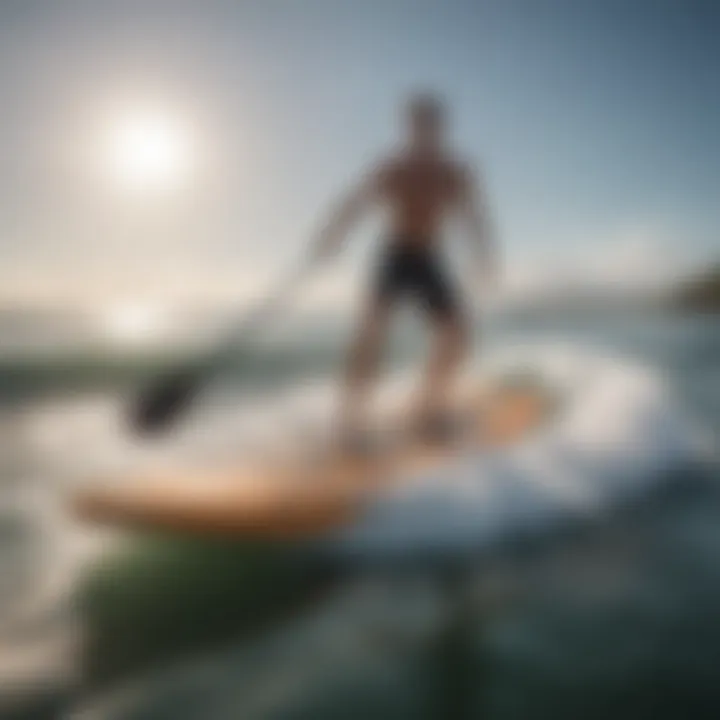
Intro
The world of paddleboarding is undergoing a significant transformation. As innovation continues to push the limits of what we know, engines are finding their way onto these traditionally serene boards. Gone are the days when a paddle was the only tool to navigate through water. Engine-equipped paddleboards are drawing attention, offering a new twist to an age-old pastime. The merging of technology with traditional craftsmanship raises questions about the core essence of paddleboarding and what this evolution may mean for the community at large.
The discussion surrounding engine-assisted paddleboards isn't merely about speed; it's about redefining how enthusiasts interact with their environment. Whether used for leisure, racing, fishing, or just exploring hard-to-reach areas, there are layers to uncover beneath the surface. This article paves the way for an informed understanding of these evolving tools, weighing the benefits against the drawbacks, while considering how they impact both users and the ecosystems they traverse.
Navigating through the thrilling yet sometimes complex world of powered paddleboards requires a good foundation of techniques, gear requirements, and safety considerations. It’s like being handed the keys to a sports car for the first time: the thrill is palpable, yet it demands respect and understanding.
Integrating culture and innovation, this guide aims to serve not only surfers and instructors eager to ride the waves but eco-enthusiasts concerned about sustainability. Are you ready to explore paddleboards with engines? Let's paddle into the details!
Prelims to Engine-Assisted Paddleboarding
The world of paddleboarding is shifting, as more people discover the advantages of boards designed with engines. Engine-assisted paddleboarding integrates traditional paddling techniques with modern technology, bringing a fresh perspective to enjoying waterways. This innovation is not just a novelty; it represents a key evolution in the sport, making it more accessible and efficient for enthusiasts of all levels.
Understanding the Concept
At its essence, engine-assisted paddleboarding merges the joy of paddling with the convenience of powered movement. Imagine gliding through serene waters without breaking a sweat, or making longer excursions on the water with ease. This concept introduces a new dimension to paddleboarding, where paddlers can choose to rely on the engine for speed or switch to manual paddling to engage with the environment. The versatility attracts a wider audience, from thrill-seekers to leisure enthusiasts looking to explore.
In recent years, technology has made strides in enhancing these boards, incorporating lightweight engines that maintain the agility and grace expected from traditional boards. The power of an engine enables users to cover more distance in less time, which can be particularly beneficial in diverse conditions, such as strong currents or challenging waves. The idea is not only to reach places that were previously harder to access but also to enjoy the ride itself. It’s convenience wrapped in a package that still respects the craftsmanship behind paddleboarding.
Historical Context of Paddleboarding
To understand the significance of engine-assisted paddleboarding, it's vital to consider the rich history behind this sport. Traditional paddleboarding has roots in ancient Polynesian culture, where outrigger canoes were used for fishing and travel across expansive oceanic territories. It was an art honed over generations, teaching resilience and connection with nature.
Fast forward to modern times, stand-up paddleboarding started to gain traction in the early 2000s, and while it became synonymous with fitness and recreation, funnily enough, it also struggled with the limitations of manual paddling.
The introduction of engines into paddleboards is a direct response to evolving user demands and the fast-paced lifestyles of today. Paddlers want the option to enjoy watersports without the exhausting effort that comes with traditional techniques. Engines amplify that freedom, allowing adventure enthusiasts to experience more of what nature has to offer. This blend of old and new not only honors the legacy of paddleboarding but also serves to enhance it, pushing the boundaries of creativity and innovation within the sport.
"The longest distance ever paddled in one day is 68.88 miles. Imagine how much easier that could be with an engine!"
As the landscape of paddleboarding continues to change, it’s crucial for enthusiasts to understand these developments. Technology is altering not just how people paddle but where they can go and how much they experience while they’re out there. In the face of these transformations, the essence of paddleboarding—exploration, connection, and thrill—remains at the core, ensuring the activity retains its appeal across generations.
Technological Advancements in Paddleboard Design
The landscape of paddleboarding has seen considerable transformation due to innovations in design and technology. Paddleboards with engines represent a fusion of traditional craftsmanship and modern engineering. This change not only brings about enhanced performance characteristics but also makes the sport accessible to a larger audience.
Engine Mechanics and Types
Understanding the mechanics behind paddleboard engines is essential for any serious paddler looking to step up their game. Most commonly, engine-assisted paddleboards utilize compact electric or gasoline engines. Each type has its own strengths: electric engines are appreciated for their quiet operation and lower environmental impact, while gasoline engines often offer greater power and speed.
- Electric Engines: Typically lightweight and easy to maintain, they operate silently, providing a smooth ride. Notably, brands like SIC Maui and BIC Sport have incorporated electric systems that allow for extensive range without the need for frequent recharging.
- Gasoline Engines: These engines deliver robust power; however, they come at the cost of weight and noise. Paddleboards with gasoline motors, like those offered by Sea Eagle, can achieve impressive speeds, making them ideal for adventure enthusiasts chasing thrill on open waters.
An essential factor in selecting the right engine type is understanding the range of power outputs available and how they influence board performance. A lightweight engine may suffice for leisurely paddling, but those looking to traverse greater distances or engage in competitive racing may require more powerful options.
Materials Used in Engine-Integrated Paddleboards
The materials used in the construction of engine-integrated paddleboards are crucial, influencing not only the board's weight and durability but also its performance on the water. Materials are evolving to accommodate the additional stresses imposed by onboard engines.
- Polyurethane Foam Core: Found in many modern paddleboards, this type of core offers excellent buoyancy and stability while minimizing weight.
- Fiberglass and Carbon Fiber: These materials strengthen the structure without adding excessive weight. Fiberglass is widely recognized for its robustness, while carbon fiber offers a superior strength-to-weight ratio, making boards lighter and more responsive during maneuvers.
- High-Density Plastic: Commonly used for the hulls of engine-assisted boards, it provides a budget-friendly option without sacrificing too much on durability and performance.
Choosing the right combination of materials can significantly affect how the paddleboard performs, especially in terms of speed and maneuverability. Lightweight boards enhance acceleration, whereas heavier models often provide stability in tough conditions. A well-balanced board is vital, especially for those eager to explore various water environments.
"The choice of materials doesn't just impact durability; it shapes the entire experience of paddleboarding, from ease of use to navigability in different conditions."
In summary, technological advancements in paddleboard design are reshaping the watersports landscape, allowing for diverse applications and greater participant engagement. Engine mechanics and material innovation create an exciting juxtaposition between tradition and modernity, ultimately expanding the horizons for surfers, instructors, and adventurers alike.
Benefits of Paddleboards with Engines
When it comes to paddleboards equipped with engines, one can't help but notice the myriad benefits they bring to the table. Unlike traditional paddleboarding, which often calls for significant physical exertion, engine-assisted boards offer a new level of convenience and enjoyment. This section will explore not just the advantages of speed and efficiency but also how these boards foster greater accessibility for a range of skill levels.
Increased Speed and Efficiency
Speed is perhaps the most obvious advantage of paddleboards with engines. Imagine slicing through the water, breezing past your friends who are paddling away with all their might. The engines in these boards allow you to traverse larger distances in a fraction of the time. For enthusiasts aiming to reach untouched beaches or explore distant coves, engine assistance can be the game changer. It’s not just a matter of saving time, however; there is an efficiency to be gained as well. Engine-assisted boards can cover more ground while using less energy than their manual counterparts. This can come in handy during long excursions or when navigating through choppy waters, where paddling can become exhausting.
Moreover, many of these boards come equipped with settings that allow users to adjust their speed. This means you can leisurely cruise along or ramp up the intensity, all depending on your mood or requirements. That’s pretty nifty, as the versatility guarantees that both recreational users and seasoned adventurers can fine-tune their experience.
"Efficiency is not just about speed; it’s about how well you can enjoy the ride."
Furthermore, because these paddleboards can travel faster, users are afforded a more expansive playground. Take the experience of exploring lakes or rivers, where navigating the water’s twists and turns could normally take a whole day—now, it can be achieved in mere hours. The ability to travel quickly opens doors to new adventures.
Accessibility for Diverse Skill Levels
One of the most significant impacts of engine-assisted paddleboards is their capacity to bridge the gap between novice and experienced paddleboarders. Traditional paddleboarding requires a certain level of physical fitness and skill, which can deter potential newcomers. Engine-equipped boards simplify the learning curve by allowing users to focus less on the mechanics of paddling and more on enjoying their surroundings.
For instance, a family wanting to spend a day on the water might have varying levels of skill among its members. Young children or adults with limited stamina can enjoy the thrill of paddleboarding without feeling worn out. This inclusiveness promotes shared experiences that can bond families and friends in ways that might not have been possible otherwise.
Additionally, schools and facilities can use engine boards in their training programs, opening opportunities for a broad range of participants. Elderly users or those with disabilities can find newfound joy in this activity, as the strain of manual paddling is minimized. This is not just a casual day out; it can elevate someone's confidence and go a long way in promoting physical activity in communities that may not typically engage in sports.
In short, the evolution of paddleboarding, thanks to engine integration, allows it to become accessible and enjoyable for all, thereby fostering a wider appreciation for this vibrant water sport.
This shift in accessibility does not just change the sport's landscape; it encourages a communal spirit, where everyone, regardless of their ability, is welcome to experience the beauty of glide on water.
Drawbacks and Concerns
Understanding the drawbacks of engine-assisted paddleboarding is essential for anyone considering this hybrid approach. While these boards bring innovation and speed to the sport, they are not without complications that users must navigate. Addressing concerns such as weight, maneuverability, and engine reliance can provide a more balanced view for potential users. Keeping an open mind about these challenges can lead to informed decisions and enhance enjoyment on the water.
Weight and Maneuverability Issues
One of the first hurdles that aspiring engine-assisted paddleboard users face is the added weight of the engines and the materials used to house them. Paddleboards, traditionally, are easy to manage and transport, but the integration of engines can make them significantly heavier. Consider a board that weighs 25 pounds without an engine, and when equipped, it might tip the scales at over 40 pounds. This is not a trivial difference and can affect a user’s ability to carry, launch, and maneuver the board in various conditions.
Not to mention how all this weight can influence the paddler's balance. A heavier board may not glide through the water as smoothly, especially in windy conditions or choppy waters. Inexperience with handling wind resistance and the board’s reaction could lead to unsteady rides, affecting both safety and enjoyment.
"With great power comes great responsibility"—this certainly applies here, as enthusiasts must understand the unique dynamics brought about by heavier, engine-equipping boards.

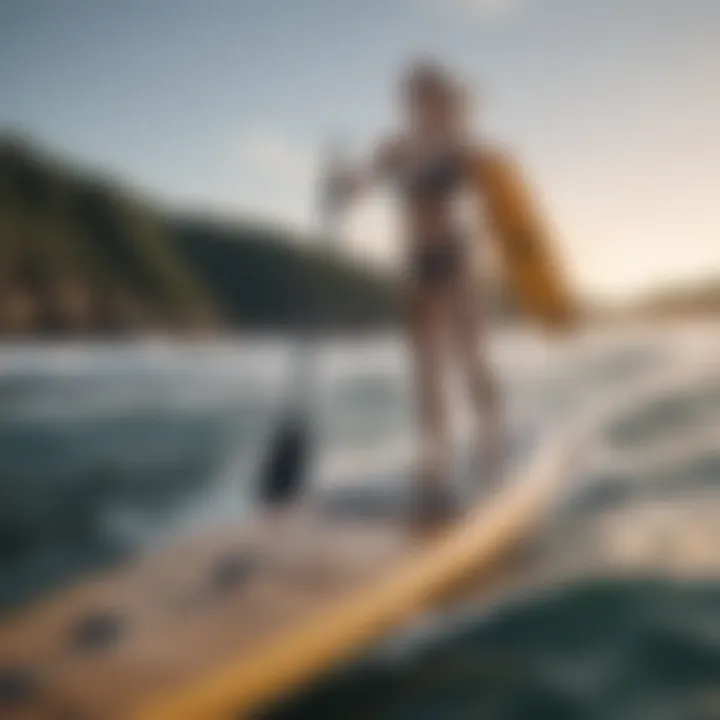
Given these considerations, potential users should evaluate their physical capabilities and intended use. A user seeking leisurely gliding across calm waters may find this weight manageable, while someone hoping for intricate maneuvering may face frequent challenges.
Dependence on Engine Performance
The reliance on engine performance also raises valid concerns. During a paddleboard journey, what happens when that engine falters? Many users may overlook this vital aspect when excitedly planning their outings. While traditional paddleboarding emphasizes human-powered resilience, engine-assisted boards can expose users to unexpected situations when the engine fails, whether due to mechanical issues or low fuel.
In numerous stories shared by paddleboarders online, there have been instances where engines have sputtered out, leaving users stranded or struggling to navigate back to shore. This dependence on technology also requires that users maintain a good level of mechanical knowledge or at least be prepared to deal with mechanical glitches—something beginner paddlers may not feel equipped for.
It’s also prudent to factor in the varied performance metrics of engines. Not all engines are created equal; some might propel a board to impressive speeds, while others might lag or consume fuel at alarming rates. Users could find themselves grappling with limited battery life, leading to uncertainty during long paddles.
On top of all this, understanding local regulations and environmental impacts become ever more significant. Some waterways may have rules about powered vessels that could limit where or how you can ride. Thus, due diligence in researching engine types, performance specifications, and local laws cannot be overlooked.
In summary, while engine-assisted paddleboarding merges innovation with traditional enjoyment, it presents challenges worth discussing. Users should weigh the pros and cons carefully to get the most out of their time on the water.
Safety Considerations for Engine-Assisted Paddleboarding
When venturing into the world of engine-assisted paddleboarding, safety becomes a chief concern. Unlike traditional paddleboards, the inclusion of an engine introduces a plethora of unique hazards. Awareness of these dangers and how to mitigate them is paramount for a fruitful experience on the water. The stakes are high, given the unpredictability of weather, water conditions, and the inherent risks associated with using powered equipment on natural bodies of water.
Key facets of safety in engine-assisted paddleboarding include the proper use of safety gear, understanding the inherent risks of operating an engine on water, and maintaining a heightened state of awareness regarding one’s surroundings. By addressing these issues, enthusiasts can minimize incidents and maximize enjoyment.
Safety Gear and Precautions
Safety gear is the unsung hero of paddleboarding. While it may be tempting to hit the water after a quick glance at the safety equipment list, close attention is required to make sure nothing is overlooked. Here are crucial items every paddleboarder ought to consider:
- Personal Flotation Devices (PFDs): Always wear a life vest or PFD that meets the safety standards. Ensure it fits snugly and is comfortable enough to wear all day.
- Leashes: A leash is not just a stylish accessory—it’s a safety measure. In rough waters, it keeps you tethered to your board, preventing separation in a glance.
- Whistles or Sound Devices: A small yet effective tool for signaling help if needed. A whistle can carry much farther than a voice, especially in noisy environments.
- First Aid Kit: Accidents happen, and having basic medical supplies on hand can make a world of difference in case of cuts or scrapes.
- Temperature-appropriate Clothing: Always dress suitably for the weather. Hypothermia can set in faster than folks realize, especially in cooler waters.
"When it comes to enjoying time on the water, preparation is your best friend. It can be the thin line between a memorable trip and a regrettable escape to shore."
Taking precautions goes beyond just having gear. Always conduct periodic checks of the equipment, ensuring the engine is in good working condition and following the manufacturer’s guidelines for regular maintenance.
Maintaining Awareness on Waterways
Maintaining awareness while paddleboarding is crucial. Engine-assisted paddleboards can travel at much higher speeds than the traditional ones, making it vital to stay vigilant. Here are several strategies to enhance consciousness while on the water:
- Stay Attuned to Surroundings: Observe other vessels, floating debris, and natural obstacles. Birds diving into water can be an indicator of underwater rocks or shallow areas.
- Weather Monitoring: Pay heed to any weather changes; dark clouds or strong winds can appear out of nowhere and can wreak havoc on your plans. It's wise to check forecasts before heading out.
- Use Technology Wisely: GPS devices and apps can be beneficial, but a misplaced dependence on technology can yield dangerous outcomes. Use these tools to supplement rather than replace your awareness.
- Communicate With Others: If you're with a group, establish a plan for communication. Avoid wandering too far apart in case one needs assistance.
In a world where technology meets adventure, the blend of vigilance and preparedness can lead to exhilarating experiences while paddleboarding with an engine. By keeping these safety considerations top of mind, enthusiasts can navigate the waters with both confidence and capabilities.
Regulatory and Legal Aspects
When dealing with paddleboards equipped with engines, understanding the regulatory and legal landscape is essential. Unlike traditional paddleboarding, which primarily falls under water sports regulations, engine-assisted paddleboarding introduces an array of new rules and requirements that users must adhere to. These regulations can vary widely from place to place, impacting everything from usage to safety protocols. Navigating these waters is crucial not only for compliance but also for the safety and enjoyment of users.
Navigating Local Laws and Regulations
Local laws form the backbone of any activity in the water, and paddleboarding with an engine is no exception. Each state or region may have distinct rules governing the use of motorized boards. Many places require users to register their engine-equipped paddleboards, similar to traditional motorboats. This act not only legitimizes the use of these boards but also ensures that safety standards are upheld. Furthermore, age restrictions may apply, requiring younger users to have specific licenses or training.
It is important to research the local laws thoroughly. For instance, areas that designate certain waterways as restricted zones may prohibit the use of engines altogether. Likewise, rules about noise levels, and times allowed for usage could also exist, ensuring that communities are not disturbed. Being informed can save users from hefty fines and, more importantly, can play a part in preserving the environment and local ecosystems.
Insurance Requirements for Engine-Integrated Paddleboards
Insurance is another critical aspect that users should not overlook. While traditional paddleboards may not necessitate insurance, the engine-assisted variety often do, due to the higher risk associated with motorized activity. Typically, users are advised to acquire liability insurance, providing coverage against accidents or damages that may occur during operation.
These policies can vary widely in their coverage options. Some may cover damage to the board itself, while others focus strictly on third-party liabilities. Engaging with an insurance professional knowledgeable about water sports can help users find policies that suit their needs.
"An ounce of prevention is worth a pound of cure."
Being proactive by understanding both the local laws and insurance requirements can prevent significant issues down the line, making the paddleboarding experience more enjoyable and safe for everyone involved.
In summary, as engine-assisted paddleboarding grows in popularity, navigating the various regulatory landscapes becomes a more pertinent issue. By staying informed and proactive, users can avoid legal troubles and focus on enjoying the water.
Environmental Impact of Paddleboards with Engines
The rise of paddleboards with engines brings about a myriad of discussions concerning their environmental footprint. As enthusiasts embrace these innovative craft, it is essential to reflect on the both the benefits and concerns surrounding their use on our waterways. Understanding the environmental implications can aid in making informed decisions that can contribute positively to eco-sustainability.
Carbon Footprint Analysis
When it comes to engine-equipped paddleboards, the carbon footprint they present is an aspect worth diving into. Typically, the emissions from these engines can vary widely, particularly between electric and gas-powered systems. Gas-powered paddleboards emit more carbon dioxide, which can spell trouble for pristine aquatic environments.
"The environmental impact of each engine type is not merely an afterthought but a major player in the sustainability equation."
Electric alternatives, while greener, do come with their own set of challenges. The energy needed to charge them often comes from fossil fuel-derived energy sources. Therefore, exploring the carbon footprint isn't just about emissions from the water; it's a broader look at the lifecycle of energy consumption. To paint a clearer picture:
- Gas-Powered Paddleboards
- Electric Paddleboards
- Emit greenhouse gases directly
- Contribute to water pollution through spills and leakage
- Generally cleaner during use
- Lifecycle emissions depend on the source of electricity
For a meaningful assessment, it's essential to calculate not just operational emissions but also how the actual production and disposal of these boards affect the environment.
Sustainable Practices in Paddleboarding
In light of environmental concerns, sustainable practices in paddleboarding are garnering attention. It's not merely about choosing what engine to power your board; it extends to how you engage with the environment. There are various strategies that can be employed:
- Choose Environmentally-Friendly Materials:
Selecting boards made from sustainable materials can significantly reduce ecological impact. - Regular Maintenance:
Keeping the engines and the boards in good shape prevents leaks and inefficiencies, minimizing any adverse effects on the water and wildlife surrounding. - Promote Eco-Conscious Usage:
Encouraging users to paddle in areas that are less sensitive to disturbance can aid in preserving delicate ecosystems. - Community Awareness:
Joining or forming communities focused on eco-friendly practices fosters a culture of responsibility among riders. Educating fellow enthusiasts about the effects of their choices is crucial.
Adopting these sustainable practices not only enhances the enjoyment of paddleboarding but also contributes to the preservation of waterways.
Market Trends and Consumer Preferences
Understanding market trends and consumer preferences is pivotal in the landscape of paddleboards equipped with engines. This sector is evolving rapidly, driven by innovation and shifting lifestyle choices. As those who surf, instruct, or adventure on the water know all too well, the needs and desires of paddlers influence current designs and future prospects.
The surge in popularity of engine-assisted paddleboards is influenced by a blend of factors that range from user convenience to environmental consciousness. The rise of recreational activities has brought forward a new demographic of paddlers, many of whom seek the thrill of speed but also desire accessibility. Thus, the market has witnessed an upsurge in engine-integrated products that cater to both seasoned surfers and novices alike.
Current Market Leaders in Engine-Assisted Paddleboards
A handful of brands have established a strong presence in the engine-assisted paddleboard market, each with their own unique offerings that appeal to different segments of consumers. For instance, brands like Aquaglide, BIC Sport, and Sea-Doo have carved out niches. Their products demonstrate a commitment to leveraging modern technology while staying true to the core principles of paddleboarding.
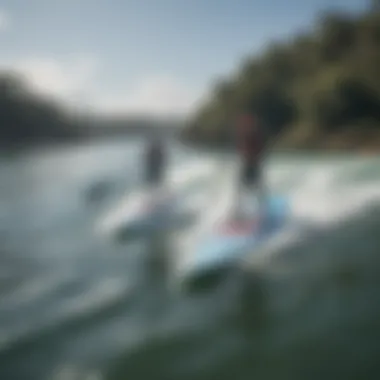
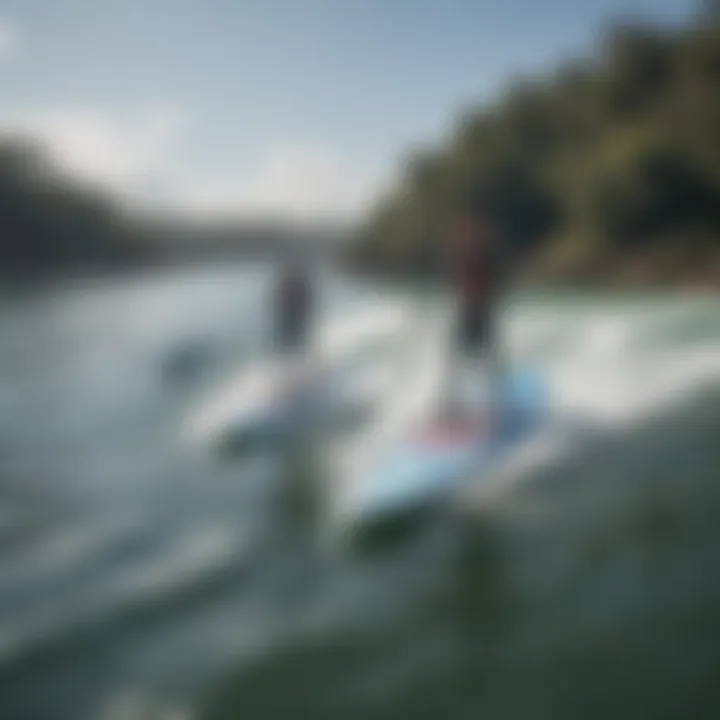
- Aquaglide has been noteworthy for its lightweight designs and user-friendly interfaces, making their paddleboards particularly appealing to beginners.
- BIC Sport targets a wide audience by presenting a range of models that suit various skill levels, effectively bridging the gap between traditional paddleboarding and modern engineering.
- Sea-Doo takes a keen interest in high-performance boards, pushing the limits of speed and stability, attracting more performance-oriented riders.
Each of these market leaders has tapped into the diverse needs of paddleboarders, elevating their products through continuous innovation and keen understanding of customer feedback.
Consumer Feedback and Product Reviews
When it comes to making informed decisions, consumer feedback is invaluable. Digital platforms and social media allow users to share their experiences, influencing potential buyers. Reviews often highlight aspects such as ease of use, performance, and reliability of engine systems.
User testimony often touches on:
- Performance Efficiency: Many users praise the increased speed and ease in covering distances without exerting significant physical effort.
- Maintenance: More advanced users provide insights about the maintenance requirements for various models, indicating that some engines require relatively less upkeep compared to others, which can be a deciding factor for buyers.
- User Experience: Positive reviews showcase enhanced experiences, particularly in open water and recreational settings where traditional paddling may not suffice.
While reviews can be mixed, overall trends suggest a growing satisfaction among consumers. Reports on platforms like Reddit indicate many users appreciate the innovations driving the designs of these paddleboards. It appears that both growth in consumer expectations and advancements in technology will continue to shape the future trajectory of engine-assisted paddleboards, setting high standards for quality and performance.
User Experiences and Testimonies
Understanding user experiences and testimonies adds invaluable insights into the world of engine-assisted paddleboarding. As enthusiasts venture into both the recreational and professional landscapes, the narratives they develop shape perceptions, challenge designs, and influence new paddlers on what to expect. Each story reveals not just the fun and excitement, but also the challenges that come with incorporating engines into a sport that has long been cherished in its more traditional forms.
Recreational Use Cases
In the realm of recreational paddleboarding, stories often highlight the sheer joy that engine-assisted models bring. Many recreational paddlers appreciate the enhanced mobility. Imagine a sunny afternoon on a sprawling lake where families gather, quenching thirsts for adventure. Paddlers can cover considerable distances without the fatigue that can often settle in after hours of traditional paddling. For instance, one user recounts how their family reunion turned into an unforgettable escapade across a nearby bay, all thanks to their engine-equipped board. It enabled everyone, from kids to grandparents, to join in the adventure rather than simply playing catch-up.
In addition to enjoying longer paddles, many users celebrate the versatility of their boards. Engine-assisted models allow for a mix of serene exploration and spirited racing. A casual paddler who had previously shied away from open waters due to physical limitations found newfound confidence. With the push from the engine, they could glide seamlessly over the water, relishing the tranquility of nature while keeping up with friends. This blend of speed and ability to control one's journey offers a unique perspective on the sport.
Benefits of Recreational Use Cases:
- Accessibility for varied skill levels.
- Opportunities for families to bond.
- Enhanced exploration of wider waters.
"The engine has really changed the way we connect with nature it’s like a passport to places we never thought we could reach."
– A recreational user on the open seas.
Professional Versus Casual Use
Professional paddleboarders experience the engined boards in a different light, often focusing on speed, performance, and efficiency in time-sensitive situations. In competitive environments, the integration of engines can spark debate among purists who argue embracing technology strays from the essence of paddleboarding.
However, many professionals argue that the engines enhance their training routines. They save energy during long practice runs, allowing them to focus on skill enhancement rather than sheer endurance. For instance, a competitive athlete preparing for a race may utilize an engine to ensure maximum output during sprint sets while keeping fatigue at bay. This advantage could ultimately redefine training standards in competitive circles, leading to a shift in how a new generation prepares for paddleboarding challenges.
Conversely, casual users often find themselves torn when observing professionals. Watching a race where engines play a pivotal role can spark interest, yet it may also plant seeds of doubt about the purity of the sport. This engenders a conversation worth having—where does one draw the line between innovation and traditional craft?
Considerations:
- Professionals may emphasize enhanced performance metrics, while casual users may prioritize fun and simplicity.
- The discussion around engine usage can foster divides within communities; however, it also enriches the conversation on the future of paddleboarding.
In essence, user experiences reflect the multifaceted journey of motorized paddleboarding, combining innovation with traditional ideals. Each narrative, whether from a spirited weekend adventurer or dedicated professional, weaves a rich tapestry of insights valuable for the community at large.
Comparative Analysis with Traditional Paddleboards
When we chat about paddleboards these days, it’s impossible to ignore the way engine-assisted models have crept into the scene. Comparing these modern boards to traditional ones is crucial for understanding how innovation reshapes our relationship with water sports. It goes beyond just technology; it’s about performance, accessibility, and a community that’s evolving at a rapid pace.
Performance Metrics
Performance metrics truly tell the tale when we line up engine-assisted paddleboards against their classic counterparts. It’s not merely about speed, though that’s a significant standout. Engine-assisted boards have a knack for retaining higher velocities over long distances, making them a preferred choice for long-haul outings.
However, speed isn’t everything. Traditional paddleboards, with their streamlined designs, often facilitate a more intimate connection with the water, offering subtle responsiveness that many riders, especially purists, cherish. It’s where technique meets water; every stroke resonates with the waves.
An interesting point to ponder is how endurance plays out in these comparisons. Engine-assisted boards allow riders to venture into areas that might take serious effort on a manual board, such as lengthy estuarine explorations or open sea traverses.
"Speed can be thrilling, but mastering a paddleboard traditionally can heighten skill and connection with the water."
A deeper dive into metrics involves endurance rates, maneuverability, and stability during heavy conditions. Engine-assisted boards might tip the scales on flat waters, but question marks linger on their stability amid choppy waves. Traditional boards are often sturdier under turbulent conditions, showcasing their resilience that seasoned surfers and adventurers appreciate.
User Demographics
The user demographics associated with engine-assisted paddleboards are a mixed bag, blending technology enthusiasts with newer paddleboard users who crave ease of access. Many first-time users who might feel intimidated by traditional paddling find a cozy spot on engine-assisted models. The engine makes it far simpler for them, breaking down intimidation barriers that can snuff the fun out of a good day on the water.
On the flip side, traditional paddleboarding still draws a solid crowd. The demographic here usually consists of loyal enthusiasts and professionals who enjoy not just the ride but also the craft of paddling itself. Those who lean toward environmental consciousness often favor traditional methods, signaling not just a choice but a lifestyle.
In the grand picture, engine-assisted paddleboards cater to a broader audience, including families looking for leisurely adventures and older enthusiasts who might appreciate the power of propulsion lessening physical strain. Traditional boards continue attracting devoted surfers and those seeking a meditative escape on the water where connection to the environment is prioritized.
In striking the balance between the two, it’s apparent that the paddleboarding community is diversifying, fostering conversations and relationships as diverse as the sea itself. Whether one prefers the modern or the traditional, there's a space for all under the sun and on the water.
Future of Engine-Assisted Paddleboarding
The discussion on the future of engine-assisted paddleboarding strikes at the core of innovation meeting tradition on the water. As more enthusiasts embrace this modern take on a timeless sport, it’s clear that the path ahead is not just paved with advancements but also shaped by evolving user expectations and environmental considerations. For those passionate about paddleboarding, understanding where this fusion of technology leads is crucial for both individual experiences and the community as a whole.
Emerging Technologies
Emerging technologies in the realm of paddleboarding are poised to revolutionize the sport. Manufacturers are now trying out lighter materials, cutting-edge battery solutions, and even smart technology integration. Some boards are beginning to incorporate solar energy panels, which could harness the sun's power while you're enjoying a ride on the waves. One practical example includes devices that can automatically adjust the engine's power based on the environment you are paddling in, ensuring a smoother experience no matter the conditions.
Moreover, the introduction of intuitive controls tailored for both experienced surfers and newbies alike is in the pipeline. Think about using a mobile app to monitor your paddleboard's performance metrics. Bord users could possibly check battery status, navigate waterways with GPS, and access real-time weather updates. This clunky tech of in the past is gradually transforming into user-friendly interfaces, making paddleboarding more accessible.
"The shift toward tech-enhanced paddleboards mirrors broader trends in outdoor recreation, where simplicity meets sophistication."
Market Forecasts and Innovations
As we peer into the horizon, market forecasts suggest a strong upward trend in the adoption of engine-assisted paddleboards. Analysts highlight that the growing interest in water sports coupled with an increased emphasis on eco-friendly technology will spawn innovations yet unseen. The modern paddler — from thrill-seeking adventurers to casual enthusiasts — is becoming more conscious of their environmental footprint, pushing brands to think green.
Predictions indicate that within the next decade, we may see an influx of biocomposite materials being utilized in paddleboard production. These materials not only reduce environmental impacts but also enhance the lifespan and durability of the products. Furthermore, subscription services for maintenance and upgrades might emerge, allowing users to stay ahead in a rapidly changing tech landscape without voiding their warranties.
In addition to upgrades in materials and sustainability practices, there is the potential for partnerships with tech companies. Bringing in expertise from the marine technology sector could lead to groundbreaking innovations in engine performance and eco-friendliness. Not to forget, collaborations between brands and surfers could inspire new product lines that capture the essence of what it means to paddleboard in harmony with nature while leveraging modern advancements.
All in all, the interplay between innovation and the traditional craft of paddleboarding is unfolding in exciting ways. For both seasoned surfers and those just starting out, grasping the implications of these developments will be vital to navigating the waters of tomorrow.
Maintenance and Care for Paddleboards with Engines
Maintaining paddleboards equipped with engines is not just a casual chore; it's a crucial aspect of sustaining their performance and safety over time. The integration of engine mechanics into traditional paddleboards introduces unique care requirements. Without proper maintenance, users may encounter increased issues that could hinder enjoyment or even lead to accidents. Thus, establishing a routine for the upkeep of these innovative boards is a step that every user should embrace for both reliability and peace of mind.

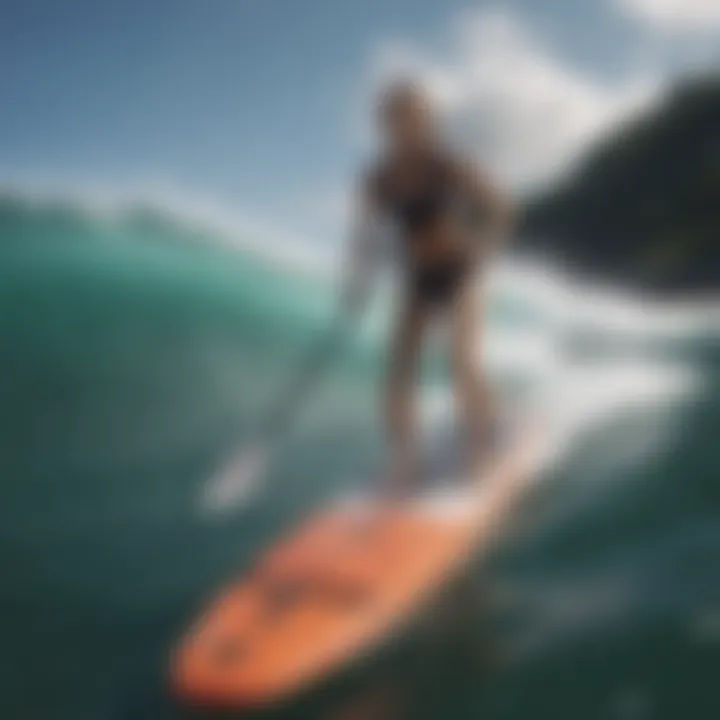
Routine Maintenance Checklists
Engaging in regular maintenance can go a long way in prolonging the lifespan and performance of an engine-assisted paddleboard. Here are key areas to focus on:
- Inspection of the Engine: Ensure that the engine is securely mounted and check for any loose connections. Look for signs of wear or corrosion on components. Unattended issues can escalate, leading to costly repairs.
- Battery Care: If your paddleboard runs on a battery, inspect the battery terminals periodically for corrosion and ensure they’re clean. It's best to charge the battery after each use, but don’t let it drain completely as that can shorten its lifespan.
- Hull Cleaning: After each trip, rinse the hull with fresh water to remove salt or debris. A clean hull reduces drag, improving efficiency.
- Propeller Condition: Examine the propeller for any dings or damage. A damaged propeller can impact speed and maneuverability. Always clear any obstruction before usage.
- Oil Checks: Similar to a motor vehicle, check the oil levels regularly. Change the oil as recommended by the manufacturer to ensure the engine runs smoothly.
- Storage Considerations: In regions where paddling isn’t year-round, consider how you store your paddleboard. Store it in a cool, dry place to avoid damage from extreme temperatures or humidity.
By adhering to this checklist, users can enjoy their paddleboards with confidence, knowing that they have taken the necessary steps to maintain their equipment.
Troubleshooting Common Issues
Even with meticulous care, issues can still arise. Here's how to tackle some common problems:
- Engine Won't Start: If your engine won't start, check the fuel level and the battery first. It can also be beneficial to refer to user manuals to troubleshoot specific issues related to engine types.
- Strange Noises: Any unusual sounds should be investigated immediately. Sounds such as grinding can indicate problems with the propeller or internal engine parts.
- Loss of Power: This could result from various factors, including a clogged fuel filter or issues with the spark plug. Regularly replacing worn-out parts can help cycle out potential problems before they escalate.
"Prevention is better than cure," especially when it comes to paddleboard maintenance.
- Vibration Problems: Excessive shaking during operation may signal that the propeller is out of balance or that there are loose components on the paddleboard. Ensure everything is tightened properly to maintain smooth operation.
- Water Ingress: If water enters the hull, it could compromise the board's integrity. Always check for cracks and ensure all seals are intact. Repair any leaks immediately to prevent further issues.
Taking the time to familiarize oneself with both routine checks and troubleshooting techniques not only enhances the paddleboarding experience but is integral in fostering a safe and efficient ride.
The Community Perspective: Paddleboarding Groups
Understanding the community perspective surrounding paddleboarding groups is vital in today's environment where traditional crafts intersect with innovation. These groups serve as a microcosm of diverse passions, experiences, and knowledge, creating a vibrant tapestry that enriches the paddleboarding landscape. It’s interesting to note how these communities foster not only relationships among users but also a collaborative spirit that advocates for engine-assisted paddleboarding. As we explore this dynamic, several key elements emerge.
Advocacy for Engine-Assisted Paddleboarding
Engine-assisted paddleboarding has not only introduced new utility but also sparked an advocacy movement among various paddleboarding groups. Enthusiasts argue that these boards can open up the waterways to broader audiences. Those who might have hesitated to enter the water sport realm, perhaps due to physical limitations or intimidating conditions, find a welcoming hand in this innovation. Engine-assisted models could transform a casual outing into a memorable adventure, providing the ease of access that many desire.
Community advocates often organize events and workshops to showcase the benefits of these paddleboards. These gatherings allow potential users to test equipment and receive firsthand information about safety practices, maintenance needs, and tactical navigation on water. Education is key; the more informed the community is, the greater the chance that more people will embrace engine-assisted paddleboarding.
"When you bring together the right people around a common passion, you create a powerful movement that can affect change in the most thoughtful way."
Debate on Engine Usage Within the Surf Community
Despite the enthusiasm around engine-assisted paddleboards, there’s a notable debate present within the surfing community. For many traditionalists, the surf ethos is entrenched in the idea of naturalism and purity in paddling. The sounds of the oars against the water and the quiet moments of reflection are often celebrated. Critics argue that incorporating engines could detract from these experiences, introducing elements that disrupt the serenity of nature and potentially harm marine life.
Esoteric discussions arise around the environmental impacts linked to engine usage. Questions are raised about noise pollution and possible disturbances to the local ecosystems. It creates a divide that sometimes manifests in social media forums, especially on platforms like Reddit and Facebook, where passionate users present arguments both for and against engine-assisted paddleboarding.
To build bridges across this divide, some propose hybrid-model discussions where traditional paddleboarding methods are respected while still allowing space for engines. Advocates for engine usage stress that, when done responsibly, this innovation could coexist harmoniously within the surfing culture. Balancing the weight of historical reverence with contemporary demands will likely be the heart of this ongoing dialogue.
As these conversations take place, it becomes evident that the community's involvement adds layers of depth to the paddleboarding experience. By thoughtfully considering the pros and cons of engine-assisted boards, we engage in a discourse that shapes the future of paddleboarding. The interplay between tradition and innovation is not merely a debate; it's a journey that all engaged parties must navigate together.
Practical Tips for New Users
Choosing to navigate the world of engine-assisted paddleboarding can feel like embarking on an adventure into largely uncharted waters. In this evolving landscape, it’s not just about the thrill of speed or the allure of innovation; it also requires a grasp of practical tips that can help both novices and seasoned paddlers make informed choices. This section aims to guide you through critical factors, ensuring your experience remains exhilarating while also practical and safe.
Choosing the Right Engine-Integrated Model
Selecting the right engine-integrated paddleboard is akin to picking the perfect partner for a dance; compatibility and mutual understanding are key. Here are some important considerations:
- Intended Use: Are you aiming for leisurely paddling or high-speed excursions? Models like the Aqua Marina Swift are designed for quick exploration, while others focus on stability for casual outings.
- Weight Capacity: Each board has a weight limit that should not be exceeded to maintain performance. Review specifications carefully to match it with your body weight and any gear you're bringing along.
- Power Source: Understand the type of engine that best fits your needs. Electric engines are quieter and friendlier to the environment, while gas-powered options may offer more speed.
- Portability: Consider the convenience of transporting your board. Some paddleboards, such as the Jobe Aero series, are inflatable and come with carry bags, making them easier to handle.
Having clarity on these aspects can make the selection process smoother and more focused.
Initial Setup Guidance
Once you've chosen your ideal paddleboard, the next step is to properly set it up. Getting the initial setup right can significantly enhance your first experience on the water. Here are detailed steps for a successful initiation:
- Check for Complete Components: Before heading out, ensure that all parts are included in your package - board, engine, any fittings, and manuals, especially if you purchased from brands like BIC Sport or Sevylor.
- Fuel or Battery Prep: If your board is engine-powered, double-check the fuel level or battery charge. A full tank or charged battery will prevent any unexpected hiccups while on the water.
- Understand Engine Operation: Familiarize yourself with the engine controls. Each model could have unique configurations that differ from traditional paddleboards, so reading your manual is a must. Watching video tutorials online can be helpful, especially those shared on forums like Reddit or communities on Facebook.
- Careful Launching: When you’re ready to hit the water, choose a gentle slope to launch your board smoothly. Look out for any debris in the water that might obstruct your path.
- Safety Gear Requirement: Wearing a life vest is non-negotiable. No matter your skill level, unexpected situations can arise, and staying safe should be your top priority.
"Proper preparation prevents poor performance!" This old saying rings true here; taking these initial steps ensures that your paddleboarding journey kicks off without a hitch.
Following these guidelines can significantly enhance your initial paddleboarding experience, providing a sense of security and assurance as you venture out. Engaging with communities, whether online or offline, will also enrich your learning curve, as seasoned users often share valuable insights away from the theory. Happy paddling!
Cross-Disciplinary Insights: Marine Engineering and Paddleboarding
The intersection of marine engineering and paddleboarding represents a fascinating blend of technical expertise and outdoor leisure. It's essential to understand how marriage of these fields fosters innovation in design while enhancing the overall paddleboarding experience.
Applying Engineering Principles to Design
When marine engineering principles come into play, the design of paddleboards evolves significantly. For instance, engineers utilize hydrodynamic concepts to shape the board for optimal speed and stability. By calculating water flow and resistance through simulations, they can determine the most efficient designs that reduce drag, making boards faster and easier to control.
Moreover, material choice is essential in this context. Modern paddleboards often leverage lightweight and durable materials like carbon fiber and reinforced plastics, providing strength without the heft. This not only influences performance but also affects usability across various waters—think choppy seas versus serene lakes. Ultimately, these engineering principles are a foundation from which innovation sprouts, guiding the latest trends in paddleboard design.
Innovations from Marine Technology
The development of engine-assisted paddleboards showcases significant advancements drawn from broader marine technology. Recent innovations, such as electric propulsion systems, spotlight how seamless integration of technology can enhance the paddleboarding experience. The introduction of silent yet powerful motors allows paddlers to explore vast water bodies with minimal environmental impact.
In addition, navigational technologies have also seen a remarkable evolution. Features like integrated GPS systems and sonar technology ensure paddlers can always find their way, enhancing safety and exploration potential. These advancements not only appeal to the adventure-seeker but also engage a new wave of eco-conscious riders who appreciate the reduced environmental footprint offered by modern engines.
"In the world of paddleboarding, technology is not merely about speed but about crafting an experience that respects nature while amplifying joy across diverse water conditions."
As we see, the collaboration between marine engineering and paddleboarding cultivates an environment ripe for innovation. These enhancements not only redefine how we paddle but also deepen our connection to the waterways we cherish.
The End: Balancing Tradition and Innovation
Melding the charm of traditional paddleboarding with the dynamism of modern engine technology has lent new life to an age-old pastime. The exploration of paddleboards equipped with engines is more than merely a trend; it’s a pivotal shift that acknowledges how technology can enhance rather than replace our beloved watersport. By dissecting this intricate dance of tradition against the backdrop of innovation, one can appreciate its multi-faceted benefits—a deeper interaction with nature, an extended range of exploration, and a newfound accessibility for varying skill levels.
Reflections on Paddleboarding Evolution
Over the years, paddleboarding has seen a remarkable transformation. Initially, riders relied solely on their physical prowess, gliding through lakes and rivers propelled by their own strength. As time passed and the surf community evolved, the introduction of broader boards made the craft more inclusive, inviting newcomers and offering a blissful day on the water without the demands of challenging paddle techniques. Now, with the advent of engine-assisted paddleboards, we stand on the cusp of another evolution.
Engines bring forth significantly increased speeds and efficiency, resulting in a real game-changer for adventure seekers yearning to cover greater distances without the fatigue of traditional paddling. This will enable a whole new generation to experience the thrill of exploring distant shorelines and hidden coves that were previously inaccessible. While the essence of paddleboarding remains untouched, the infusion of technology invites enthusiasts to rethink how they engage with waterways. So, while purists may harbor sentiments toward the acoustic sound of paddles cutting through water, many others see the potential for heightened enjoyment and safety.
Future Directions and Community Engagement
As the landscape continues to shift, community involvement becomes paramount. It's not just about the boards; it's about the culture that surrounds them. Therefore, fostering dialogue among enthusiasts, manufacturers, and local policymakers is crucial. Those who cherish paddleboarding can play a vital role in shaping regulations that strike a balance between innovation and the environment.
Looking ahead, we could see:
- Development of even lighter engines to preserve the overall feel of paddling.
- Increased focus on eco-friendly technologies that enhance performance while protecting ecosystems.
- Community-based initiatives that promote responsible usage—anything from educational workshops on safety to organized outings that uphold environmental stewardship.















